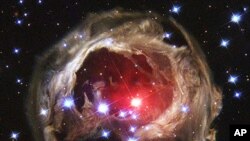Astronomers at the European Southern Observatory (ESO) say new data indicates there is an abundance of rocky Super-Earth-type planets orbiting in the habitable zones of a common type of star known as a red dwarf. They estimate there are tens of billions within our Milky Way galaxy alone.
Super-earth is the term astronomers use to describe a type of rocky planet outside our solar system - an exoplanet - that measures less than 10 times the mass of the Earth.
The ESO astronomers say their calculations show that about 40 percent of all red dwarf stars have a super-Earth orbiting within a habitable zone where liquid water can exist on the surface of the planet - the best indicator for the possibility of extraterrestrial life.
The researchers made the new findings from data collected with the planet-finding HARPS spectrograph at ESO’s La Silla observatory in Chile. They say HARPS’ observations provided the first direct measurement of the frequency of super-Earths orbiting red dwarf stars.
Red dwarfs are small, cool stars that have an extraordinarily long evolutionary life, and therefore are very common. They comprise an estimated 80 percent of the stars in the Milky Way - that amounts to around 160 billion red dwarfs.
The results of a separate study announced earlier this year indicated that rocky Earth-like worlds far outnumber massive gas-giant planets in the Milky Way galaxy.
The new ESO study will be published in the journal, Astronomy and Astrophysics.
Red dwarfs may be among the most ubiquitous of stars in the cosmos, but our relatively young, bright, yellow Sun is not one of them.
The Milky Way galaxy has a diameter of approximately 120,000 light years. That means it would take 120,000 years for light to travel across the galaxy. The speed of light is 300,000 kilometers per second.
News
Milky Way Likely Has Tens of Billions of Rocky 'Super-Earths'






